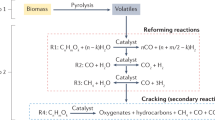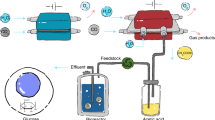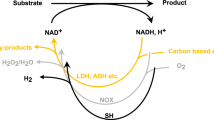Abstract
Although in theory the amount of hydrogen that could be generated from renewable sources of energy such as cellulose (a polymer of glucose) is vast1, only 16–24% of the maximum stoichiometric yield of hydrogen from glucose (about 12 mol H2 per mol glucose) is typically achieved by biological methods2. Here we show that the enzymes of the oxidative pentose phosphate cycle3,4,5 can be coupled to hydrogenase purified from the bacterium Pyrococcus furiosus, one of only a few hydrogenases that use NADP+ as the electron carrier6, to generate 11.6 mol H2 per mol glucose-6-phosphate. Hydrogen produced by this pathway is the major product, unlike that produced by intermediate metabolic pathways of bacterial fermentation, and therefore has important practical implications for biohydrogen production7.
This is a preview of subscription content, access via your institution
Access options
Subscribe to this journal
Receive 51 print issues and online access
$199.00 per year
only $3.90 per issue
Buy this article
- Purchase on Springer Link
- Instant access to full article PDF
Prices may be subject to local taxes which are calculated during checkout

Similar content being viewed by others
References
Woodward, J. et al. Nature Biotechnol. 14, 872– 874 (1996).
Keasling, J. D. et al. in Biohydrogen (ed. Zaborsky, O. R.) 87– 97 (Plenum, New York, 1998).
Horecker, B. L. & Smyrniotis, P. Z. Arch. Biochem. 29, 232–241 ( 1950).
Couri, D. & Racker, E. Arch. Biochem. Biophys. 83, 195–205 (1959).
Lehninger, A. L. Biochemistry 2nd edn (Worth, New York, 1975).
Ma, K., Zhou, Z. H. & Adams, M. W. W. FEMS Microbiol. Lett. 122, 245–250 (1994).
Benemann, J. R. Nature Biotechnol. 14, 1101–1103 (1996).
Lee, J. W. et al. Science 273, 364–367 (1996).
Greenbaum, E. Photobiochem. Photobiophys. 8, 323– 332 (1984).
Stull, D. R., Westrum, E. F. & Sinke, G. C. in The Chemical Thermodynamics of Organic Compounds 680 (Wiley, New York, 1969).
Lide, D. R. & Frederikse, H. P. R. CRC Handbook of Chemistry and Physics 5-16, 5-24 (CRC, London, 1995).
Chenault, H. K. & Whitesides, G. M. Appl. Biochem. Biotechnol. 14, 147–197 (1987).
Nakajima, H. et al. ACS Symp. Ser. 466 (eds Bednarski, M. D. & Simon, E. S) 111–120 (Am. Chem. Soc., Washington DC, 1991).
Author information
Authors and Affiliations
Corresponding author
Rights and permissions
About this article
Cite this article
Woodward, J., Orr, M., Cordray, K. et al. Enzymatic production of biohydrogen. Nature 405, 1014–1015 (2000). https://doi.org/10.1038/35016633
Issue Date:
DOI: https://doi.org/10.1038/35016633
This article is cited by
-
Analysis of the hydrogen yield for the ethanol steam reforming
Biomass Conversion and Biorefinery (2023)
-
A mini review on microwave and contemporary based biohydrogen production technologies: a comparison
Environmental Science and Pollution Research (2022)
-
Streamlined hydrogen production from biomass
Nature Catalysis (2018)
-
Uphill production of dihydrogen by enzymatic oxidation of glucose without an external energy source
Nature Communications (2018)
-
Homogeneously catalysed conversion of aqueous formaldehyde to H2 and carbonate
Nature Communications (2017)
Comments
By submitting a comment you agree to abide by our Terms and Community Guidelines. If you find something abusive or that does not comply with our terms or guidelines please flag it as inappropriate.



